« April 2016 | Main | June 2016 »
May 31, 2016
ReFocus: The Films of Amy Heckerling

Edited by Frances Smith and Timothy Shary
Edinburgh University Press - 2016
Color me clueless. Until I read this study on Amy Heckerling's films, I had no idea that there were several critical books about "teen movies". I should not have been surprised with my own ventures into genre studies. That there is an academic book on Heckerling also caught me off guard. I still remember when, even in the early Seventies, there were those who thought it absurd that the films directed by Alfred Hitchcock should be taken seriously as art.
Unsurprisingly, most of the essays here are about Fast Times at Ridgemont High and Clueless, Heckerling's best known and most critically acclaimed work. Regarding Fast Times, what is usually thought of as Heckerling filming Cameron Crowe's screenplay, adapted from his book, is reframed with discussions on how Heckerling changed the screenplay in collaboration with Crowe, to make the film more gendered balanced, as well as changing how female sexuality was presented. The essays on Clueless review how much of the idiosyncratic language and fashion styles of Cher Horowitz and her friends were invented for the film.

Amy Heckerling at a recent retrospective.
The more academic of the essays position Heckerling's films within the context of gender and language studies. There is also a comparison with John Hughes, reminding us that Heckerling directed the Hughes written script, National Lampoon's European Vacation. Heckerling's work in television is also given a brief overview.
In terms of film studies, the point is brought up that female directors making studio films are usually limited to teen films or the kind of comedies that, until recently, have not been given much critical attention. Heckerling's theatrical film output has been sporadic following the release of Clueless. Part of the problem is that there are significantly fewer mid-budget movies produced by the studios, then during the dozen years between Fast Times and Clueless. The other problem is the entrenched attitudes that have limited female directors in Hollywood. At a time when young men who make moderately successful indie films are signed up to film comic book based films with huge budgets, Heckerling has had to fight in spite of the box office success of the first Look Who's Talking ($297 million box office against a $7.5 million budget), or the critics' awards for Clueless.
While Heckerling's work is discussed extensively in terms of gender, what seems to be overlooked is her culturally Jewish identity. Cher Horowitz? Certainly. Dora Diamond of Loser? Could be. But both films are notable for having the young female characters choose guys for their intellect and sensitivity over looks and wealth.
It should be mentioned that a future entry in the ReFocus series will be on Kelly Reichardt, a female filmmaker who has been able to work consistently outside the studio system.

Thai poster for Fast Times at Ridgemont High
Posted by Peter Nellhaus at 04:52 PM
May 29, 2016
Coffee Break
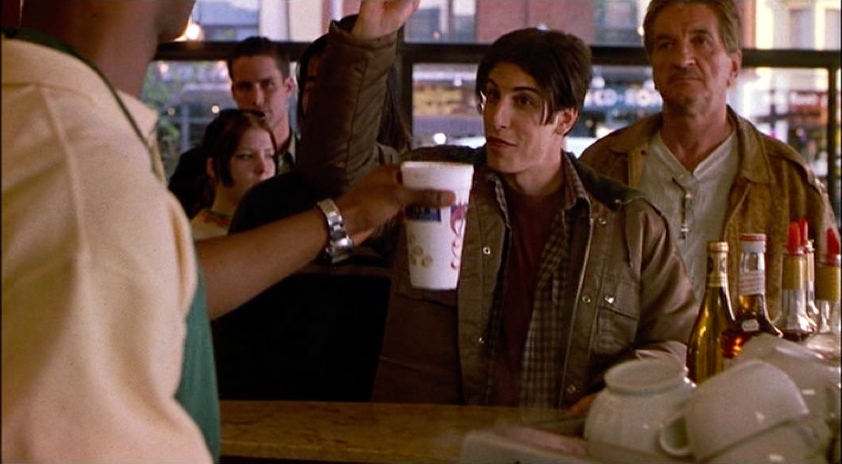
Jason Biggs in Loser (Amy Heckerling - 2000)
Posted by Peter Nellhaus at 09:13 AM
May 25, 2016
Fever
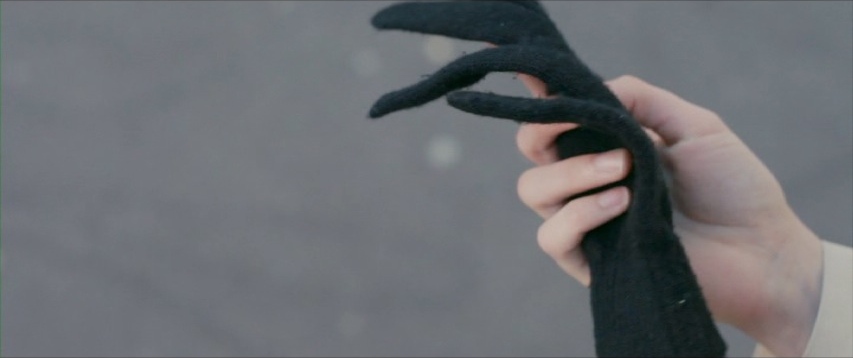
Raphael Neal - 2014
Artsploitation Films Region 1 DVD
What makes Fever a significant break from the various films inspired by the Leopold-Loeb murder case is that it is an attempt to put the crime into a far bigger philosophical context. I'm not familiar with Leslie Kaplan's novel, though I assume that most of the ideas explored in Raphael Neal's film originated there. Neal, an actor making his directorial debut, co-wrote the screenplay.
The two young men here are younger, both French high school seniors, inspired by flimsy philosophy. The victim is a prostitute. The murder is never shown. We are introduced to the two boys, Pierre and Damien, as they run downstairs and onto the Paris sidewalk. Pierre bumps into a woman along the way, and drops a glove. The woman, Zoe, an optician, picks up the glove. Following news reports and some neighborhood talk, she suspects that Pierre and Damien are the suspects sought by the police.
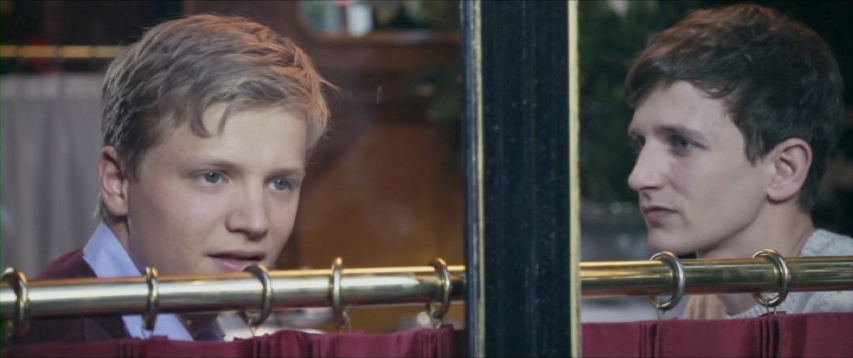
Neal cross-cuts between Damian's upper class, brightly decorated home, and Pierre's family, more people in a smaller, somewhat dingy apartment. At school, Hannah Arendt's book on Adolf Eichmann. It is eventually revealed that Damian's grandfather was a functionary during World War II for the Vichy government, who helped in the process of the expulsion of French Jews. Pierre's grandmother was sent to a camp. From this point, the film is primarily an exploration of Arendt's ideas of the "banality of evil" as it applies not only to those who supported the Nazis either by action or inaction, but how it manifests in contemporary society.
What's not clear is the connection to the song made famous by Peggy Lee, played at one point in Damian's house, and performed at a concert by Camille, who provides the film's soundtrack. More to the point as pop culture references is when Pierre and Damien pass by a a theater with posters for A ma soeur, Picnic at Hanging Rock and Klute, collectively films where the death and disappearance seem to be random. From what I have read about the novel, it goes into greater detail concerning how Pierre and Damian respond to the historical events that have had a personal impact, as well Kaplan discussing the questions of personal and collective responsibility. At this time, Kaplan's novel is not available in English translation.
There's perhaps more philosophy than can be fully expressed within a film that runs less than ninety minutes. Some of the ideas discussed here, though, make Fever extremely timely, not only considering some of the recent activity in France, but in the United States as well.
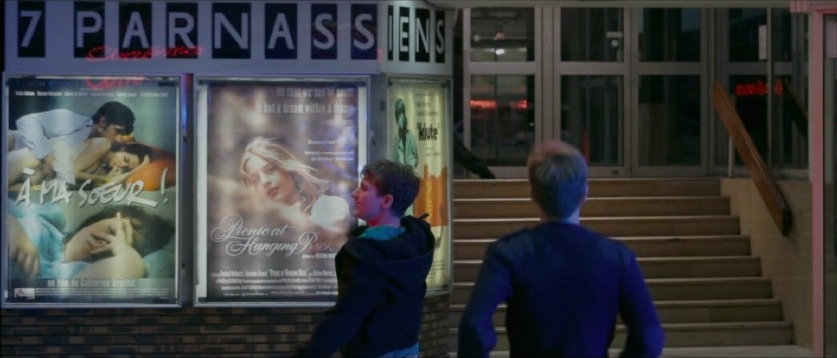
Posted by Peter Nellhaus at 03:02 PM
May 23, 2016
The Chase

Arthur Ripley - 1946
Kino Classics BD Region A
It's appropriate that UCLA was one of the participants in the restoration of The Chase. Arthur Ripley was the school's first teacher in the famed film school, from 1957 through his death in 1961. There was a short break from academia to direct, at the request of Robert Mitchum, Ripley's best known film, Thunder Road. This was also the last film restored under the direction of UCLA Film & Television Archive preservationist Nancy Mysel, prior to her death in 2012.
We first see Robert Cummings as Chuck Scott, wearing a suit, but unshaven, with scuffed shoes, standing in front of a restaurant where the cook has pancakes and bacon frying on the griddle. Obviously hungry, Cummings pulls his belt in another notch. And then he takes a bottle from his jacket and gulps a pill, without anything to wash it down. It's later indicated that Scott may be suffering from what was then called "shell shock" as a post-war Naval veteran. What is never commented on is that Scott is seen popping pills several times throughout the film, including one time washing a pill down with beer. I'm pretty sure that even back in the Forties, professional opinion held that the combination of psychotropic medication and alcohol wasn't a smart idea.
Cummings might be hungry, but he's also honest. After treating himself to breakfast with cash from a very conveniently discovered lost wallet, Cummings returns the wallet to the owner. Eddie Roman lives in a mansion in a very posh section of a studio set Miami, Florida. Roman lives up to his name as there are statues everywhere in his elegant home. Steve Cochran takes on the part of Roman, a guy who never hesitates to let you know who's in control. The first indication that The Chase is more violent than comparable films of the era comes when Roman slaps a manicurist hard enough for blood to trickle from one side of her mouth. Scott is rewarded for his honesty by being hired as Roman's chauffeur. It turns out that Roman is a back seat driver, with a pedal that allows him to speed at 120 mph, and hope that the driver remains in control of the steering. Peter Lorre plays Roman's right hand man, the one who does the dirty work on behalf of his boss.

There is Roman's wife, Lorna, usually held under lock and key at the mansion. Roman trusts Scott enough to let him take Lorna out of the house for a drive to a beach. As Lorna, Michele Morgan, wears fancy, and overly formal, long dresses, looking out at the ocean while contemplating her unhappy life as a trophy wife. Lorna talks Scott into helping her escape to Havana. Even when fleeing her husband, Lorna remains overdressed, wearing a mink coat for her cruise to Havana.
The plot, such as it is, is nonsense. There is a wonderful dream sequence where Scott has been framed for murder. Stepping further back, based on Scott's pill-popping, I think it's possible to imagine all of The Chase as a drug induced hallucination.
What can not be disputed is what Arthur Ripley was able to accomplish on a limited budget. There are a couple of overhead shots, including one traveling crane shot within a nightclub where, unknown to each other, Roman and Scott are separated by a partition within the club. A murder is indicated by off screen sounds, and the sight of a broken wine bottle, with the spilled wine appearing like the draining of blood.
Guy Maddin provided a commentary track which covers the production of The Chase as well as notes on the careers of Ripley, producer Seymour Nebenzal, screenplay writer Philip Yordan, novelist Cornell Woolrich, as well as the film stars. Those familiar with Maddin's own films, take on not only past films but mimic the technical aspects of older films, will not be surprised by the wealth of references mentioned within the eighty-six minute running time.

Posted by Peter Nellhaus at 09:39 AM
May 22, 2016
Coffee Break

Midori Ishizuka in Voice without a Shadow (Seijun Suzuki - 1958)
Posted by Peter Nellhaus at 01:07 PM
May 17, 2016
Beat Girl - Restored and Revisited

Edmond T. Greville - 1959
BFI Flipside Blu-ray/DVD two disc set
A while back, I had read that another home video company would be offering a complete version of Beat Girl "soon". As it turned out, it was the British Film Institute to the rescue. The version of Beat Girl many of us know is the lousy VHS tape, or the even worse DVD, where the scenes in the strip club appear to have been edited by someone handling a dull meat cleaver. The BFI set offers not only the restored film as seen in UK theaters in 1960, but two additional versions as well. While I wrote about Beat Girl about ten years ago, seeing the restored film has brought up questions and connections that didn't occur to me previously.
For those who are unfamiliar, the plot concerns a young woman who goes to art school by day, and hangs out with other "beat" kids at night, and coffee houses in between. Her father has returned from three months away with his new, twenty-four year old, French wife. The girl discovers that her step-mother use to be a stripper and sometimes relied on the kindness of strangers, as it were. As some kind of act of revenge, the girl declares herself to be emancipated, visits the worse strip joint in London to join the ranks of the ecdysiasts, until fate steps in.

The screenplay began life as Striptease Girl until the censors demanded a few changes. Writer Dail Ambler began life as Betty Mabel Lilian Williams, gaining fame for her hard-boiled pulp fiction. At age 40, Ambler probably knew more about the habitués of Soho, than the emerging youth culture of the late Fifties. There is virtually nothing about a musical Ambler wrote, Take Me Over, from 1963, featuring the 1920s style band, The Temperance Seven. With many of the former restrictions gone, Night after Night after Night (1969), directed by schlockmeister Lindsay Shonteff, with a Jack the Ripper killer and more strippers would seem to offer pure, unbridled Ambler, with her last filmed screenplay. Even with revisions, Beat Girl was rated X, meaning that only those 16 and older could see the film in the UK. For those unfamiliar with the then British rating system, X was given out to films that were not pornographic. Jules and Jim was originally rated X, presumably for presenting a menage a trois. So the question is raised regarding the intended audience, when the fans of rising rock star, Adam Faith, are shut out. The X rating was for glimpses of bare breast in the strip club, a very erotic dance by the Haitian exotic performer, Pascaline, and the kids playing chicken with their heads on a railroad track while a train charges towards them. Reportedly, there was a queue for British X rated films forcing a delayed release while later films with Faith, Peter McEnery and Shirley Anne Field hit theaters first.
There is something going on between France and England that I can't get a handle on, and it's not just in the plot. Director Edmond T. Greville was a Frenchman who made several British films. British Gillian Hills, in the title role, made a career for herself as a French ye-ye singer.

In the interview with Hills included here, Greville is described as appearing to be lost. Greville was 53 at the time he made Beat Girl, and far from the guy who began his career assisting Abel Gance, Rene Clair and E. A. Dupont in the silent era. My own inclination is that producer George Willoughby may have contributed significantly behind the scenes. While Greville was a veteran nearly at the end of his career, Willoughby showed a knack identifying promising talent - Clive Donner and Ted Kotcheff early on with Nothing but the Best and Wake in Fright. Willoughby also produced a couple of films directed by Terence Young. The first, Valley of the Eagles from 1951 had a tall actor, Christopher Lee, in a supporting role. Young will always be associated with James Bond, which invokes music by John Barry. Barry got the music scoring gig, his first, due to his work with Adam Faith, then on the brink of stardom. The title theme, featuring the distinctive guitar of Vic Flick may be familiar to some as sampled in Fatboy Slim's "Rockafeller Skank" back in 1998.
While George Willoughby didn't get a youngish director, he did the next best thing by getting cinematographer Walter Lassally his first mainstream British feature credit. Lassally was the cinematographer of the most famous films from the "Free Cinema" movement. The way the camera roams around in the basement nightclub while the kids dance recalls Lassally's work for Tony Richardson and Karel Reisz's "Momma Don't Allow". Lassally, who specialized in on location filming, shot one scene in the Chislehurst Caves, illuminated by candles, as well as some shots on the streets of Soho. The dance scene, done first under the credits, and repeated with different footage later, is remarkable in that it does not appear to have been formally choreographed. Hills and Oliver Reed dance together and apart, the camera wanders over to Peter McEnery and Shirley Anne Fields moving in and out of the frame. Hills loved the opportunity to dance without inhibition. I would have loved an in-depth interview or better, a commentary track by Lassally, but he discusses filming Beat Girl briefly online.
Hills also talks about how she related to the feelings of anger expressed by her character, Jennifer. Fifteen at the time of production, Hills' mother was on the set, forcing the need for a double to be filmed in a scene when Jennifer does an impromptu strip tease in front of her friends. I get the sense that Hills' appearance in Blow-Up, nude with Jane Birkin in that film's most notorious scene served as a declaration of personal freedom for the young actress.
What Beat Girl gets right is the sense of otherness felt by the kids. The slang might not be accurate, but Dail Ambler understood that pride in having a language and culture that separated the younger generation from their parents. Even so, it's dad David Farrar, who probably felt after working with Michael Powell that Beat Girl was a steep step down, who gets the best line. Busting in on Jennifer's late night party in a family home with all the charm of a mausoleum, Farrar smashes a record against the wall, and tosses Adam Faith's guitar to the door. Letting the youngsters know what's up, Farrar yells, "Go on. Get out of it, you jiving, driveling scum!".
The release version works best because it spends the least time on the square dad and his "Frenchie" young wife. Oliver Reed and Shirley Anne Field were both 21 at the time of filming, and just a couple years older than Peter McEnery and Adam Faith, age appropriate casting. Faith's rockabilly song, "Made You", was a hit in the UK. The generous BFI set also includes a couple of very short British films from the Fifties, the kind available very specialized collectors sixty years ago, from a time when the suggestion of nudity was enough to cause excitement for some viewers. And if that wasn't enough, the BFI also included a spooky short starring two guys who would later play Dracula, Christopher Lee and Ferdy Mayne. For myself, patience has been more than rewarded.

The screen grabs are from the DVD, which like the Blu-ray, is not region locked.
Posted by Peter Nellhaus at 01:04 PM
May 15, 2016
Coffee Break

Gillian Hills in Beat Girl (Edmond T. Greville - 1959)
Posted by Peter Nellhaus at 11:29 AM
May 10, 2016
Symptoms

Jose Ramon Larraz - 1974
BFI Blu-ray/DVD two disc set
The near loss of Symptoms is a reminder that even when the idea of film preservation was gaining attention, it was still possible for even a relatively recent film to be totally lost. In the case of Symptoms, the existence of that film was visible in murky bootleg VHS tapes. The discovery of the negative was followed by digital restoration, and the newly available Blu-ray/DVD release. The film probably looks better than it did in theatrical release where it popped in a couple of grind houses stateside to critical and audience indifference. In the case of the U.S. run, it didn't help that this was one of the last films from distributor Bryanston prior to its closure from bankruptcy. Symptoms, much to the surprise of those involved, was the British entry at Cannes. It should be no surprise that an intimate horror film would be overshadowed in a line-up that included films by Francis Ford Coppola, Steven Spielberg, Robert Altman, R.W. Fassbinder and Alain Resnais, among the heavier hitters in competition.
The career of Larraz was a bit unconventional, moving from cartoons and photography to filmmaking at forty. The high points of Larraz's filmography are the handful of films made in England, signed as Joseph Larraz. Aside from the censorship of art that was standard in Spain at the time Larraz made his first films, those involved in making horror films were forced to use pseudonyms to disguise their Spanish identity. As in the other two British films I've seen, Vampyres and The House that Vanished, Larraz likes to set his films in mansions hidden in the countryside.
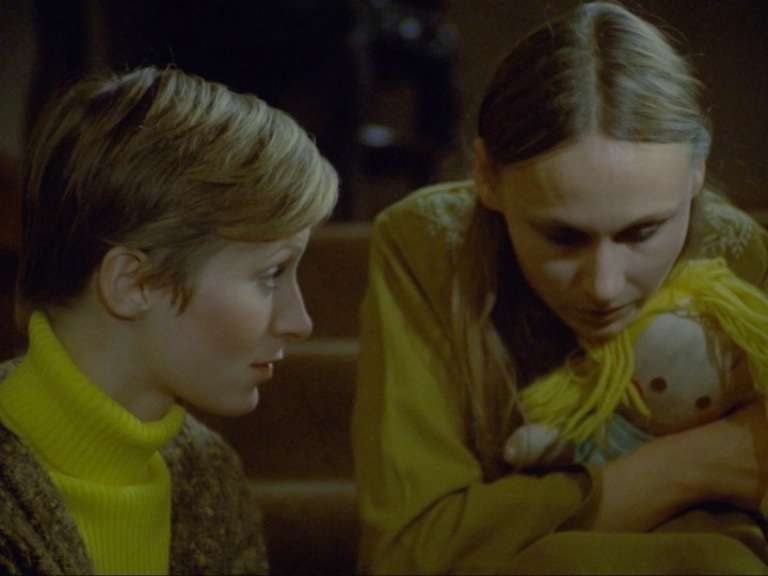
Larraz makes the most of the country setting in Symtoms, with its heavily wooded area in Autumn, and leaves nearly covering a nearby lake. The colors of Autumn are echoed frequently in the colors of the clothing worn by the two main female characters. An arm and leg of a woman can be glimpsed. Two women, Helen and Anne drive up to a very large house belonging to Anne. Only a few rooms are still used according to Helen. While Helen is returning from a visit to Switzerland, Anne is taking time from breaking up with her boyfriend. Helen is very girlish in appearance with her long hair and dresses. Anne could almost be mistaken for David Bowie with her boyish hairstyle. Yet it is Helen who glances at Anne with an unstated desire. Interrupting the shared quiet of walking through the woods and homemade meals is the presence of the handyman, Brady, who lives nearby. Seen at one point wearing a wife beater undershirt with a straight razor nearby, Brady would seem to represent brutish masculinity barging in on a refined, feminine world.
Helen has a couple of framed photos of a friend, Cora. The extent of that friendship is never discussed other than that Cora was Helen's houseguest recently. More puzzling for Anne are the sounds of laughter and moaning, either from pleasure or pain, heard late at night. There may be an unexpected visitor, glanced at as a reflection on a mirror, or heard padding around in the attic.
The Blu-ray comes with several supplements. The documentary, On Vampyres and other Symtoms, by Celia Novis, combines biography in graphic art illustrations, with excerpts from several of Larraz's early films, along with Larraz being honored at the Stiges Film Festival in 2009, with a screening of Vampyres. Novis blends shots from Larraz's films with footage of Larraz walking through parts of Barcelona and his hotel. Without having to state it outright, the documentary make the case for Larraz as an auteur based as much on the recurring visual choices as well as his interest in the fantastique. Further investigation requires a look at the writings of the Belgian writer with the pen name of Thomas Owen, who provided inspiration for Larraz. Editor Brian Smedley-Aston, who also produced Vampyres provides a unique link with British film history as the nephew of Frank Launder, one of the mainstays of classic British cinema, and editor for Tony Richardson and Desmond Davis during Britain's own New Wave of the early Sixties. Smedley-Aston, along with stars Angela Pleasence and Lorna Heilbron, are interviewed. Pete Tombs, who with Cathal Tohill, first brought renewed critical attention to Larraz with their book, Immoral Tales, produced several of the supplements. There is also a booklet which includes a deeper examination of Symptoms as well as the rave review by the then young film critic, David Pirie, written in 1974, a time when many fellow cineastes were taking seriously the genre films of the past, while often ignoring what was currently on screen.

The above screen grabs are from the DVD, which like the Blu-ray, is not region locked.
Posted by Peter Nellhaus at 05:12 PM
May 08, 2016
Coffee Break

Jennifer Lopez and Bobby Cannavale in Parker (Taylor Hackford - 2013)
Posted by Peter Nellhaus at 04:22 AM
May 03, 2016
Arabian Nights

Miguel Gomes - 2015
Kino Lorber BD Region A
As I've written before, sometimes it's a challenge to be articulate about a film that defies easy descriptions or explanations. Even reading what others have written about Arabian Nights doesn't make my work any easier. It's a sprawling collection of stories that Miguel Gomes claims were inspired by the structure of the classic tales, about life in Portugal during the government imposed austerity program between August 2013 and July 2014. Yet Gomes contradicts himself as there are moments when ancient Baghdad appears in a contemporary Mediterranean setting.
No distinctions of genre are here as Gomes floats between documentary and fantasy, past and present, political engagement and sex farce. Scheherazade told her tales over one-thousand and one nights. Gomes made a leisurely paced trio of films that runs about six and a half hours altogether. The films do need to be seen together, or at least in the proper sequence, as there are some moments that connect to previous tales. A further instance of Gomes' penchant for self-contradiction is that the second film, The Desolate One uses excerpts from Rimsky-Korsakov's "Scheherazade" suite.
It's the song, "Perfidia" that is repeated in several versions throughout the film. You've probably heard the song, even if you don't know the title, as it has been used in several other films, and recorded by a number of musicians. The lyrics are from the point of view of a betrayed lover, about the folly of romantic love. I can only guess that the song was chosen as the expression of citizen who loves his country, but feels spurned by a government that suppose to work on behalf of the least among them.
A Portuguese acquaintance expressed surprise that Arabian Nights has been getting international attention due to the specificity of most of the narratives. Gomes' stories, or story fragments, are of the working class, the ones most severely affected by the austerity programs. A factory town known for ship building sees closure of its industry, with nothing to take its place. Evictions take place at an apartment complex on such a regular basis that residents help those being evicted with sorting out their property. With nothing else to do, men in a suburb of Lisbon trap finches, and have competitions based on the birds' singing. At a trial between a landlord and tenants, multiple stories are relayed, how different people have been made desperate by the effects of the austerity measures, and the unintended cause and effect relationships that link a community.
Gomes made the interesting choice to have Thai cinematographer Sayombhu Mukdeeprom for this film. Sayombhu has been associated with Apichatpong Weerasethakul. There is some similarity between the two filmmakers as they both make allegorical films about their respective countries, real life stories are used as a starting off point, and fantasy intermingles with reality.
The Blu-ray includes a booklet with some production notes by Gomes and an essay by critic Dennis Lim. There is also Gomes discussing the first part of Arabian Nights following the screening at the New York Film Festival, and a short made mostly of documentary footage and imagined first person narratives of several European leaders, Redemption.

Miguel Gomes
Posted by Peter Nellhaus at 05:31 PM
May 01, 2016
Coffee Break

Dick Van Patten in Violent Midnight (Richard Hilliard - 1963)
Posted by Peter Nellhaus at 06:12 AM
